Differentiated Interval Structural Characteristics of Wufeng−Longmaxi Formation Deep Shale Gas Reservoirs in Western Chongqing Area, China: Experimental Investigation Based on Low-Field Nuclear Magnetic Resonance (NMR) and Fractal Modeling
Abstract
:1. Introduction
2. Geological Setting and Sampling
3. Experiments and Methods
3.1. NMR Tests
3.2. Fractal Modeling Based on NMR Data
4. Results
4.1. NMR T2 Spectrum and Related Pore Structure Parameters
4.2. Bound and Movable Fluids
4.3. NMR Fractal Characteristics
5. Discussion
5.1. Quantitative Characterization of Reservoir Pore Structure
5.2. Relationship between Fractal Dimensions and Physical Properties
5.3. Relationship between NMR Fractal Dimension and Mineral Compositions
5.4. The Particularities and Influencing Factors of High-Quality Reservoir Pore System
6. Conclusions
- (1)
- The pore structure of the Wufeng–Longmaxi Formation shale from the western Chongqing area was fractal to a degree. The fractal dimension of bound fluid pores (D1) based on NMR tests ranged from 1.6895 to 2.3821, and the fractal dimension of movable fluid pores (D2) ranged from 2.9914 to 2.9996, indicating that the pore systems are complicated and heterogeneous. In addition, both D1 and D2 can represent the complexity of the overall pore structure in the middle and upper Longmaxi Formation.
- (2)
- The pore size distribution in the Wufeng–Longmaxi shale samples in the Z-3 well was mainly in the range of 1–100 nm and 100 nm–1 µm, concentrated between 1nm and 100 nm. Mesopores and micropores provided a large proportion of the pore volume, and micropores comprised the major microstorage space.
- (3)
- The exponential correlation between shale permeability and porosity was strong. D1 and D2 had no apparent correlation with permeability and porosity, while fractal dimensions had moderately positive correlations with TOC content in the lower S1l1-1 sub-layer and its upper layers.
- (4)
- TOC content was one of the major factors influencing the gas content in the Wufeng–Longmaxi Formation shale in the Z-3 well. Specifically, an increase in TOC content resulted in greater porosity, leading to a more abundant organic matter pore network and enhanced homogeneity of the pore structure in the bottom S1l1-1 sub-layer, which showed significant potential for the exploration of shale gas.
Author Contributions
Funding
Institutional Review Board Statement
Informed Consent Statement
Data Availability Statement
Acknowledgments
Conflicts of Interest
References
- Zou, C.N.; Yang, Z.; Pan, S.Q.; Chen, Y.; Lin, S.J.; Huang, S.W.; Dong, D.; Wang, S.; Liang, F. Shale Gas Formation and Occurrence in China: An Overview of the Current Status and Future Potential. Acta Geol. Sin. (Engl. Ed.) 2016, 90, 1249–1283. [Google Scholar]
- Zhang, J.; Li, Z.; Wang, D.; Xu, L.; Li, Z.; Niu, J.; Chen, L.; Sun, Y.; Li, Q.; Yang, Z.; et al. Shale gas accumulation patterns in China. Nat. Gas Ind. B 2023, 10, 14–31. [Google Scholar] [CrossRef]
- Li, H.; Zhou, J.; Mou, X.; Guo, H.; Wang, X.; An, H.; He, S. Pore structure and fractal characteristics of the marine shale of the longmaxi formation in the changning area, Southern Sichuan Basin, China. Front. Earth Sci. 2022, 10, 1018274. [Google Scholar] [CrossRef]
- Shi, S.; He, J.; Zhang, X.; Wu, H.; Yu, Z.; Wang, J.; Yang, T.; Wang, W. Fractal analysis of pore structures in transitional shale gas reservoirs in the Linxing area, Ordos Basin. Front. Earth Sci. 2022, 10, 979039. [Google Scholar] [CrossRef]
- Nie, H.; Li, P.; Wei, D.; Ding, J.; Sun, C.; Liu, M.; Wang, J.; Du, W.; Zhang, P.; Li, D.; et al. Enrichment characteristics and exploration directions of deep shale gas of Ordovician–Silurian in the Sichuan Basin and its surrounding areas, China. Pet. Explor. Dev. 2022, 49, 744–757. [Google Scholar] [CrossRef]
- Ma, X.; Wang, H.; Zhou, S.; Shi, Z.; Zhang, L. Deep shale gas in China: Geological characteristics and development strategies. Energy Rep. 2021, 7, 1903–1914. [Google Scholar] [CrossRef]
- Nie, H.; Jin, Z.; Li, P.; Katz, B.J.; Dang, W.; Liu, Q.; Ding, J.; Jiang, S.; Li, D. Deep shale gas in the Ordovician-Silurian Wufeng–Longmaxi formations of the Sichuan Basin, SW China: Insights from reservoir characteristics, preservation conditions and development strategies. J. Asian Earth Sci. 2023, 244, 105521. [Google Scholar] [CrossRef]
- Zhang, Q.; Hou, B.; Pang, H.; Liu, S.; Zeng, Y. A Comparison of Shale Gas Fracturing Based on Deep and Shallow Shale Reservoirs in the United States and China. Comput. Model. Eng. Sci. 2022, 133, 471–507. [Google Scholar] [CrossRef]
- Dong, L.; Bian, C.; Guo, B.; Zeng, X.; Liang, S. Pore structure and reservoir physical properties for effective development of tight sandstone gas: A case study from the Central Sichuan Basin, China. Geol. J. 2022, 57, 2497–2510. [Google Scholar] [CrossRef]
- Zhu, B.; Meng, J.; Song, C.; Pan, R.; Zhu, Z.; Jin, J. Complexity and Heterogeneity Evaluation of Pore Structures in the Deep Marine Shale Reservoirs of the Longmaxi Formation, China. J. Mar. Sci. Eng. 2023, 11, 1613. [Google Scholar] [CrossRef]
- Li, C.; Shen, B.; Lu, L.; Pan, A.; Li, Z.; Zhu, Q.; Sun, Z. Quantitative Characterization of Shale Pores and Microfractures Based on NMR T2 Analysis: A Case Study of the Lower Silurian Longmaxi Formation in Southeast Sichuan Basin, China. Processes 2023, 11, 2823. [Google Scholar] [CrossRef]
- Aksnes, D.W.; Forland, K.; Kimtys, L. Pore size distribution in mesoporous materials as studied by 1H NMR. Phys. Chem. Chem. Phys. 2001, 3, 3203–3207. [Google Scholar] [CrossRef]
- Yang, R.; Liu, W.; Meng, L. Multifractal Analysis of the Structure of Organic and Inorganic Shale Pores Using Nuclear Magnetic Resonance (NMR) Measurement. J. Mar. Sci. Eng. 2023, 11, 752. [Google Scholar] [CrossRef]
- Li, C.; Tan, M.; Wang, Z.; Li, Y.; Xiao, L. Nuclear magnetic resonance pore radius transformation method and fluid mobility characterization of shale oil reservoirs. Geoenergy Sci. Eng. 2023, 221, 211403. [Google Scholar] [CrossRef]
- Fu, H.; Wang, X.; Zhang, L.; Gao, R.; Li, Z.; Xu, T.; Zhu, X.; Xu, W.; Li, Q. Investigation of the factors that control the development of pore structure in lacustrine shale: A case study of block X in the Ordos Basin, China. J. Nat. Gas Sci. Eng. 2015, 26, 1422–1432. [Google Scholar] [CrossRef]
- Song, Y.; Ravinath, K. NMR application in unconventional shale reservoirs-A new porous media research frontier. Prog. Nucl. Magn. Reson. Spectrosc. 2019, 112–113, 17–33. [Google Scholar] [CrossRef] [PubMed]
- Broseta, D.; Barré, L.; Vizika, O.; Shahidzadeh, N.; Guilbaud, J.P.; Lyonnard, S. Capillary condensation in a fractal porous medium. Phys. Rev. Lett. 2001, 86, 5313–5316. [Google Scholar] [CrossRef] [PubMed]
- Abhra, G.; Tarafdar, P.; Tapati, D. Fractal pore structure of sedimentary rocks: Simulation in 2-d using a relaxed bidisperse ballistic deposition model. J. Appl. Geophys. 2012, 87, 40–45. [Google Scholar]
- Avnir, D.; Farin, D.; Pfeifer, P. Molecular fractal surfaces. Nature 1984, 308, 261–263. [Google Scholar] [CrossRef]
- Fan, X.; Wang, G.; Li, Y.; Dai, Q.; Song, L.; Duan, C.; Zhang, C.; Zhang, F. Pore structure evaluation of tight reservoirs in the mixed siliciclastic-carbonate sediments using fractal analysis of NMR experiments and logs. Mar. Pet. Geol. 2019, 109, 484–493. [Google Scholar] [CrossRef]
- Wei, Y.; Zhao, D.; Jiao, W.; Zhang, H. Heterogeneity of mechanical brittleness in Wufeng–Longmaxi shale reservoirs in western Chongqing area-Using well Z-3 as an example. Unconv. Oil Gas 2021, 8, 67–76. [Google Scholar]
- Zhang, X.; Wang, R.; Shi, W.; Hu, Q.; Xu, X.; Shu, Z.; Yang, Y.; Feng, Q. Structure- and lithofacies-controlled natural fracture developments in shale: Implications for shale gas accumulation in the Wufeng–Longmaxi Formations, Fuling Field, Sichuan Basin, China. Geoenergy Sci. Eng. 2023, 223, 211572. [Google Scholar] [CrossRef]
- Zhao, D.; Guo, Y.; Zhu, Y. Analysis of micro-scale heterogeneity characteristics in marine shale gas reservoir: Pore heterogeneity and its quantitative characterization. J. China Univ. Min. Technol. 2018, 47, 296–307. [Google Scholar]
- Wu, Y.; Tahmasebi, P.; Lin, C.; Zahid, M.A.; Dong, C.; Golab, A.N.; Ren, L. A comprehensive study on geometric, topological and fractal characterizations of pore systems in low-permeability reservoirs based on SEM, MICP, NMR, and X-ray CT experiments. Mar. Pet. Geol. 2019, 103, 12–28. [Google Scholar] [CrossRef]
- Yang, M.; Huang, S.; Zhao, F.; Sun, H.; Chen, X. Experimental investigation of CO2 huff-n-puff in tight oil reservoirs: Effects of the fracture on the dynamic transport characteristics based on the nuclear magnetic resonance and fractal theory. Energy 2024, 294, 130781. [Google Scholar] [CrossRef]
- Zhang, J.; Li, X.; Wei, Q.; Sun, K.; Zhang, G.; Wang, F. Characterization of Full-Sized Pore Structure and Fractal Characteristics of Marine-Continental Transitional Longtan Formation Shale of Sichuan Basin, South China. Energy Fuels 2017, 31, 10490–10504. [Google Scholar] [CrossRef]
- Zhang, J.; Deng, H.; Deng, J.; Gao, R. Fractal Analysis of Pore Structure Development of Sandstone: A Nuclear Magnetic Resonance Investigation. IEEE Access 2019, 7, 47282–47293. [Google Scholar] [CrossRef]
- Zhao, P.; Wang, L.; Xu, C.; Fu, J.; Shi, Y.; Mao, Z.; Xiao, D. Nuclear magnetic resonance surface relaxivity and its advanced application in calculating pore size distributions. Mar. Pet. Geol. 2020, 111, 66–74. [Google Scholar] [CrossRef]
- Shao, W.; Ding, Y.; Xiao, F. On the method of determingT2 cutoff value with the T2 spectrum characteristics. Well LogGing Technol. 2009, 33, 430–435. (In Chinese) [Google Scholar]
- Zang, Q.; Liu, C.; Rizwan, S.; Yang, X.; Li, G.; Wu, Y.; Lu, Z.; Feng, D. Occurrence characteristics of the movable fluid in heterogeneous sandstone reservoir based on fractal analysis of NMR data: A case study of the Chang 7 Member of Ansai Block, Ordos Basin, China. J. Pet. Sci. Eng. 2022, 214, 110499. [Google Scholar] [CrossRef]
- Zhang, C.; Guan, P.; Zhang, J.; Ding, X. Methodological Study on the Full-Range Pore Structure and Fractal Characteristics of the Tight Reservoirs. Minerals 2023, 13, 587. [Google Scholar] [CrossRef]
- Liu, Y.; Zhang, L.; Zhang, X.; He, X.; Li, J.; Xing, Y.; Jin, F.; Wang, Y. Pore Structure and Fractal Characteristics of Continental Low Maturity Organic-Rich Shale in the Sha-4 Member of the Liaohe Western Depression. Energies 2023, 16, 327. [Google Scholar] [CrossRef]
- Dong, J.; Huang, Z.; Chen, J.; Li, T.; Zhao, J.; Pan, Y.; Qu, T. Pore Structure and Fractal Characteristics of Tight Sandstone: A Case Study for Huagang Formation in the Xihu Sag, East China Sea Basin, China. Energies 2023, 16, 2013. [Google Scholar] [CrossRef]
- Xi, Z.; Tang, S.; Wang, J.; Yi, J.; Guo, Y.; Wang, K. Pore Structure and Fractal Characteristics of Niutitang Shale from China. Minerals 2018, 8, 163. [Google Scholar] [CrossRef]
- Fu, Q.; Hu, Z.; Qin, T.; Feng, D.; Yang, B.; Zhu, Z.; Xing, L. Diagenesis and Pore Formation Evolution of Continental Shale in the Da’anzhai Lower Jurassic Section in the Sichuan Basin. Minerals 2023, 13, 535. [Google Scholar] [CrossRef]
- Wang, Z.; Zhu, Y.; Jiang, Z.; Gong, H.; Yang, Y.; Wang, B.; Wang, X. A Study on the Pore Structure and NMR Fractal Characteristics of Continental Shale in the Funing Formation of the Gaoyou Sag, Subei Basin. Appl. Sci. 2023, 13, 12484. [Google Scholar] [CrossRef]
- Wang, F.; Yang, K.; Cai, J. Fractal Characterization of Tight Oil Reservoir Pore Structure Using Nuclear Magnetic Resonance and Mercury Intrusion Porosimetry. Fractals 2018, 26, 1840017. [Google Scholar] [CrossRef]
- Wu, W.; Li, Q.; Pei, J.; Ning, S.; Tong, L.; Liu, W.; Feng, Z. Seismic sedimentology, facies analyses, and high-quality reservoir predictions in fan deltas: A case study of the Triassic Baikouquan Formation on the western slope of the Mahu Sag in China’s Junggar Basin. Mar. Pet. Geol. 2020, 120, 104546. [Google Scholar] [CrossRef]
- Zhu, B.; Meng, J.; Pan, R.; Hu, H.; Song, C.; Zhu, Z.; Jin, J. New insights into the evaluation criteria for high-quality deep marine shale gas reservoirs in the Longmaxi formation: Evidence from organic matter pore development characteristics. Front. Ecol. Evol. 2023, 11, 1138991. [Google Scholar] [CrossRef]
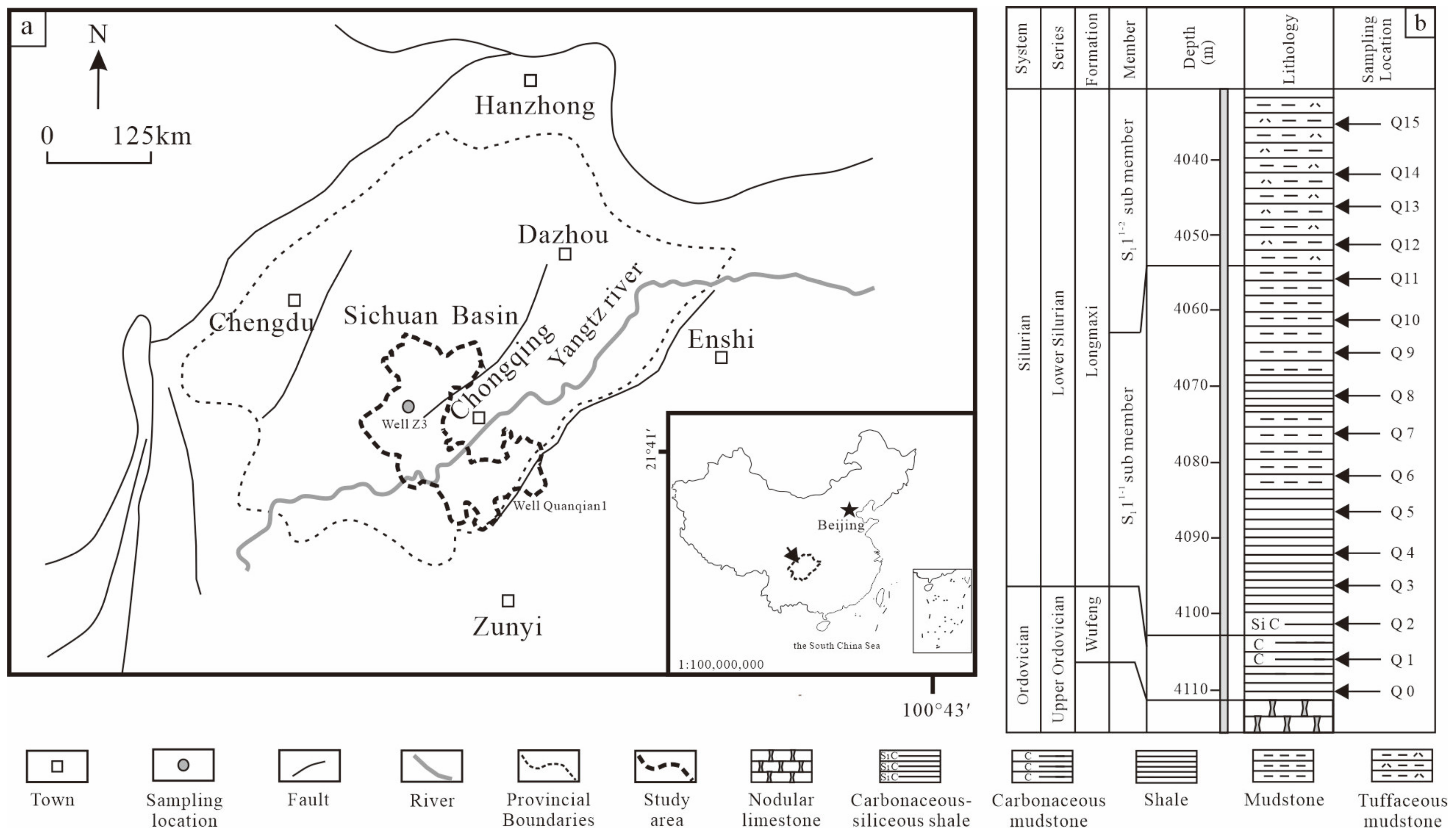
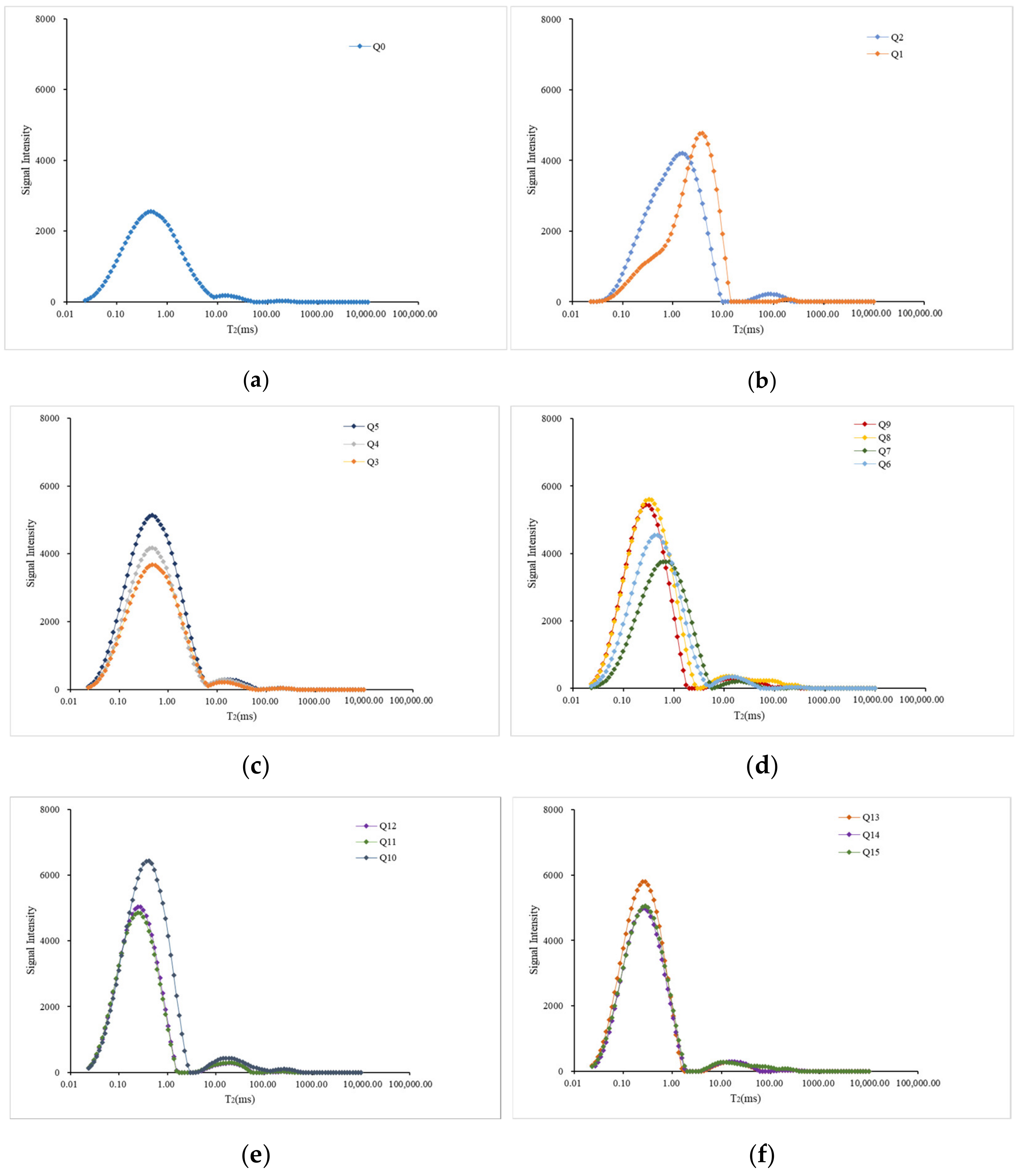
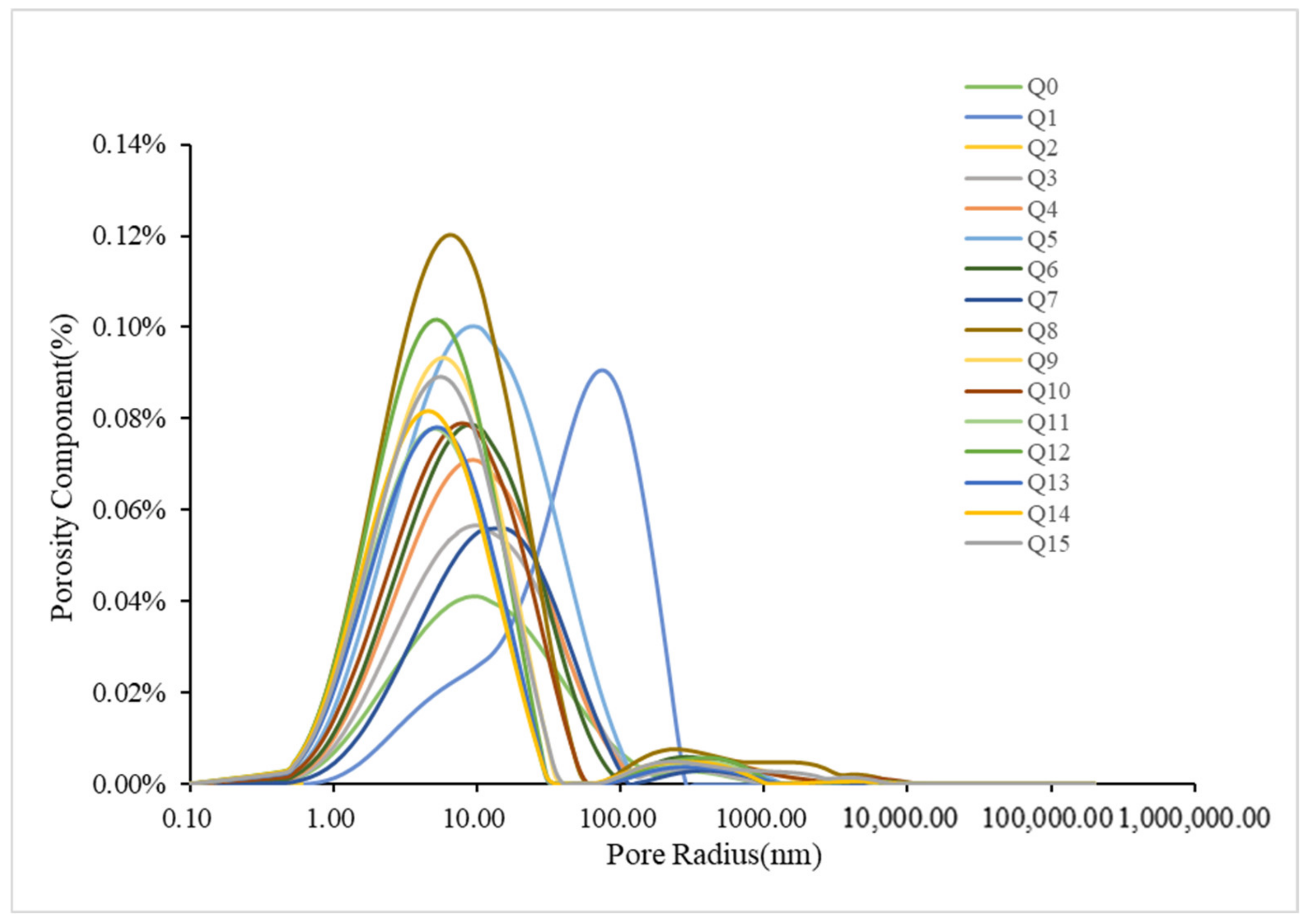
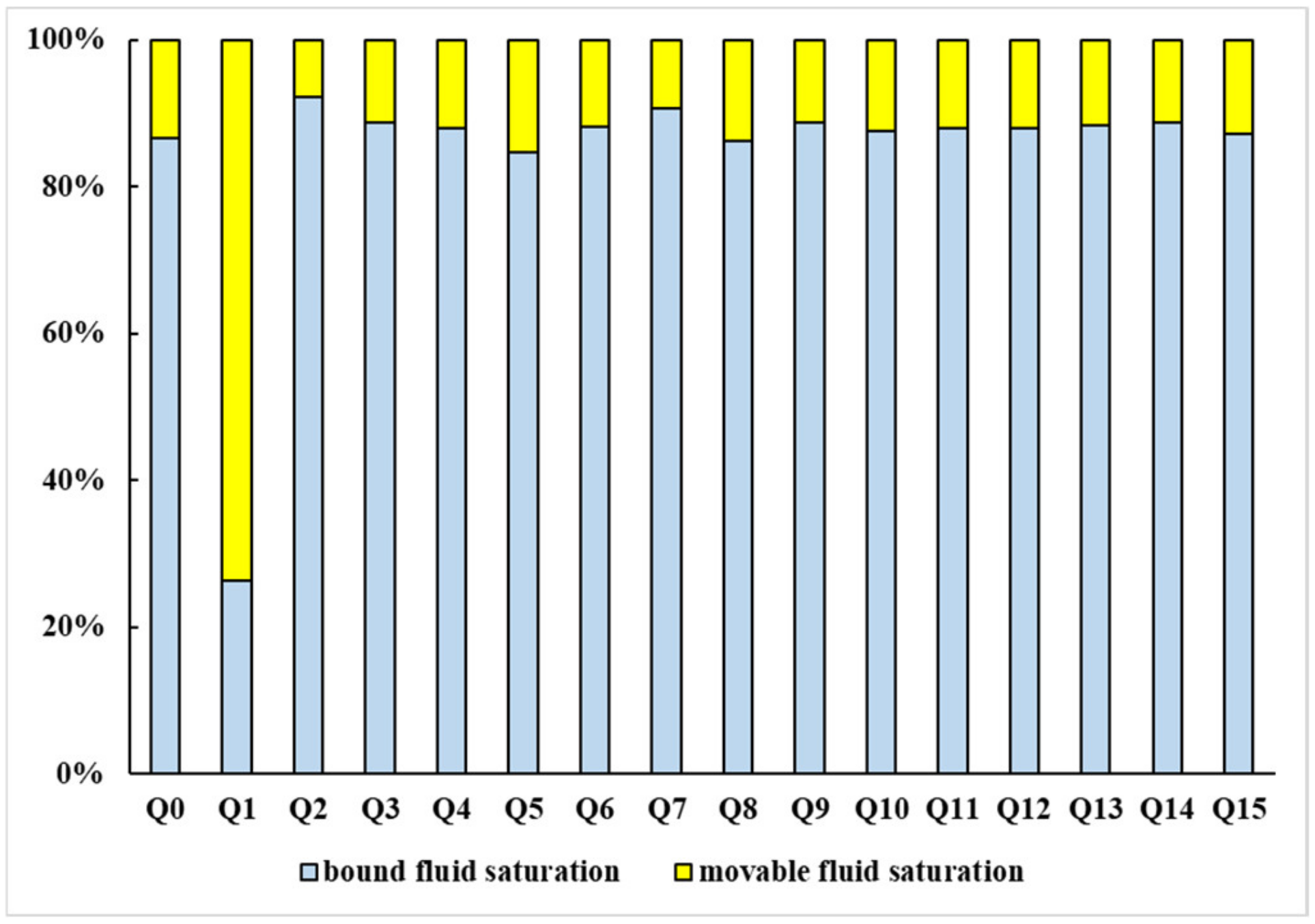
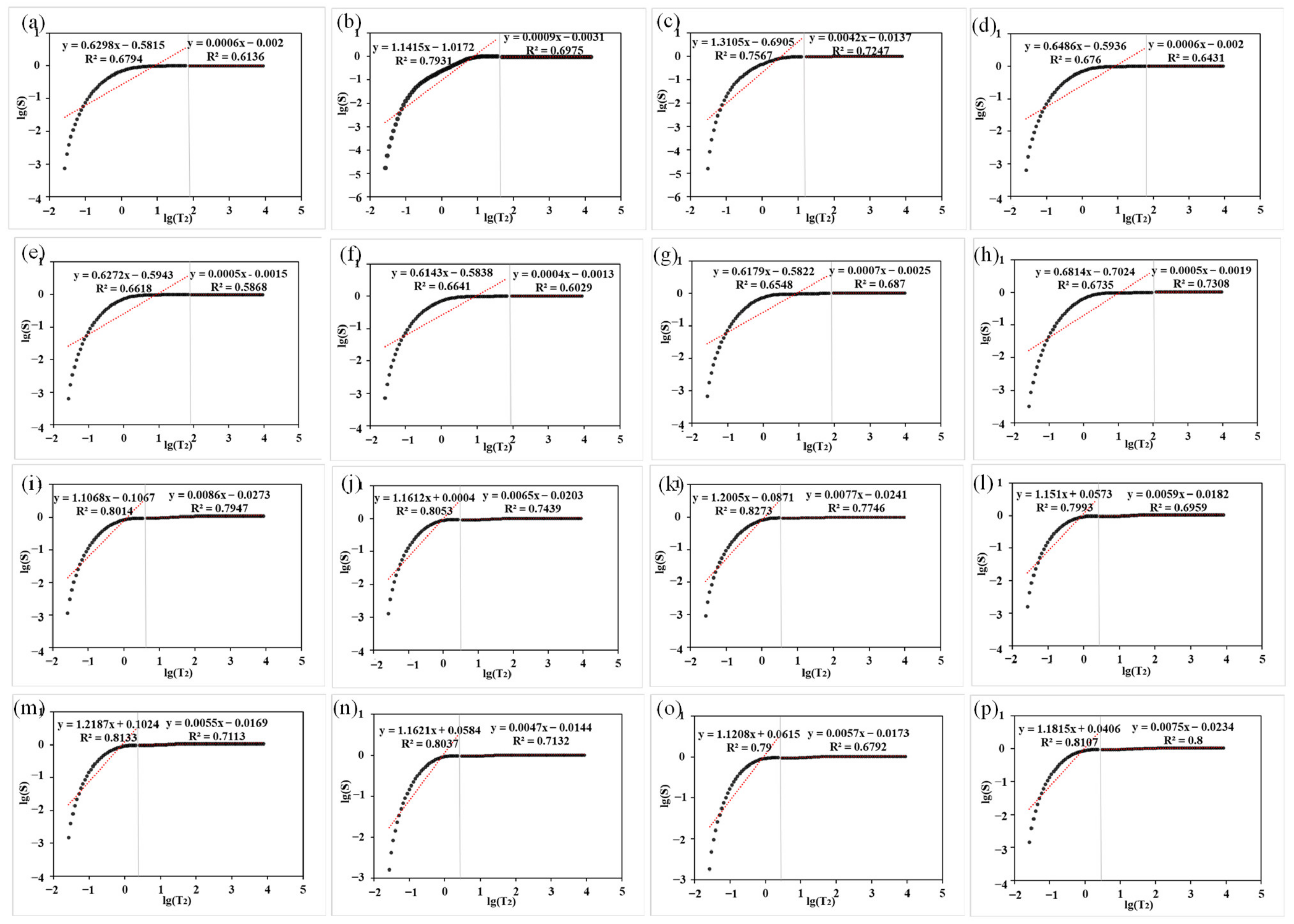

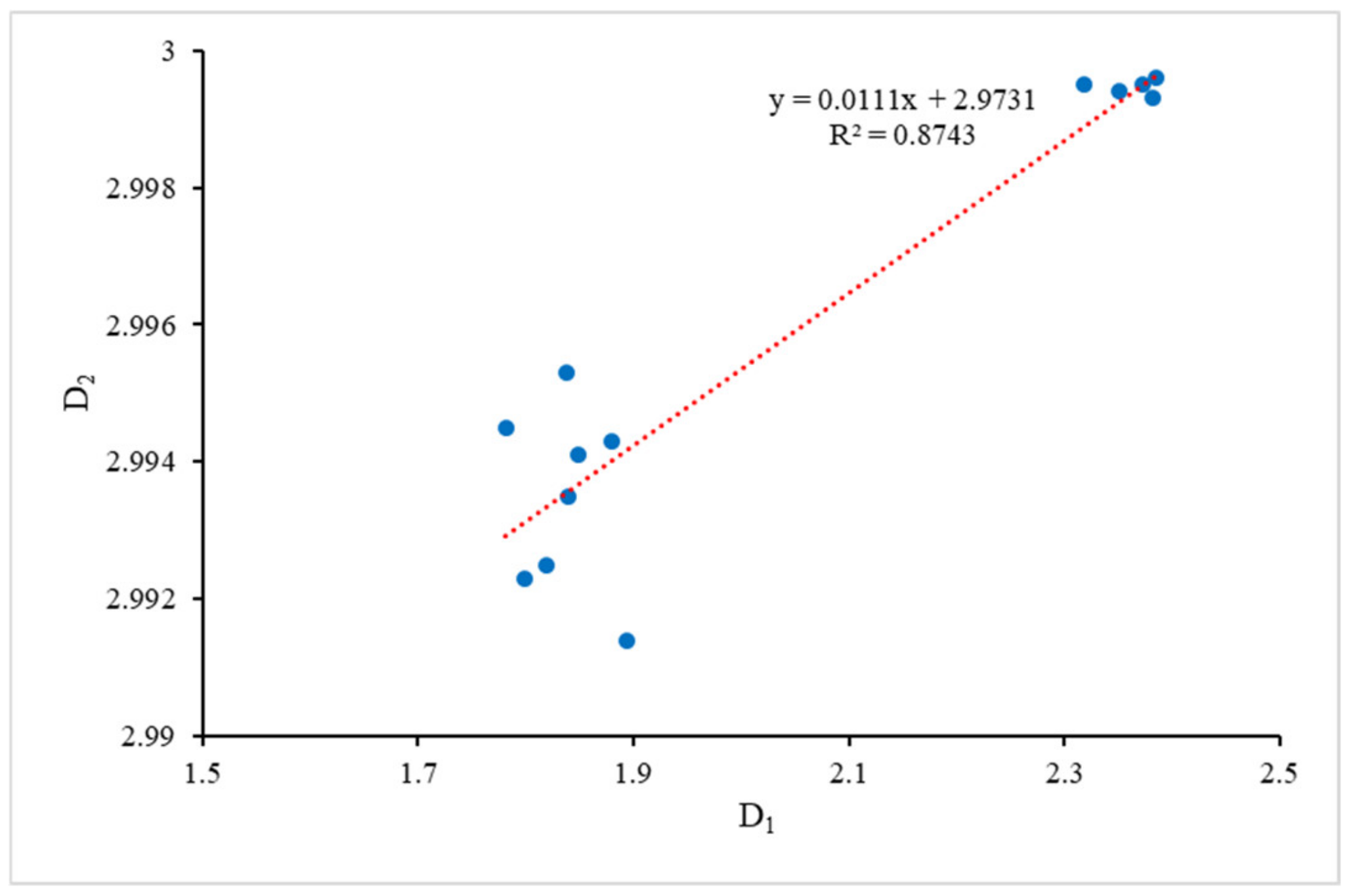

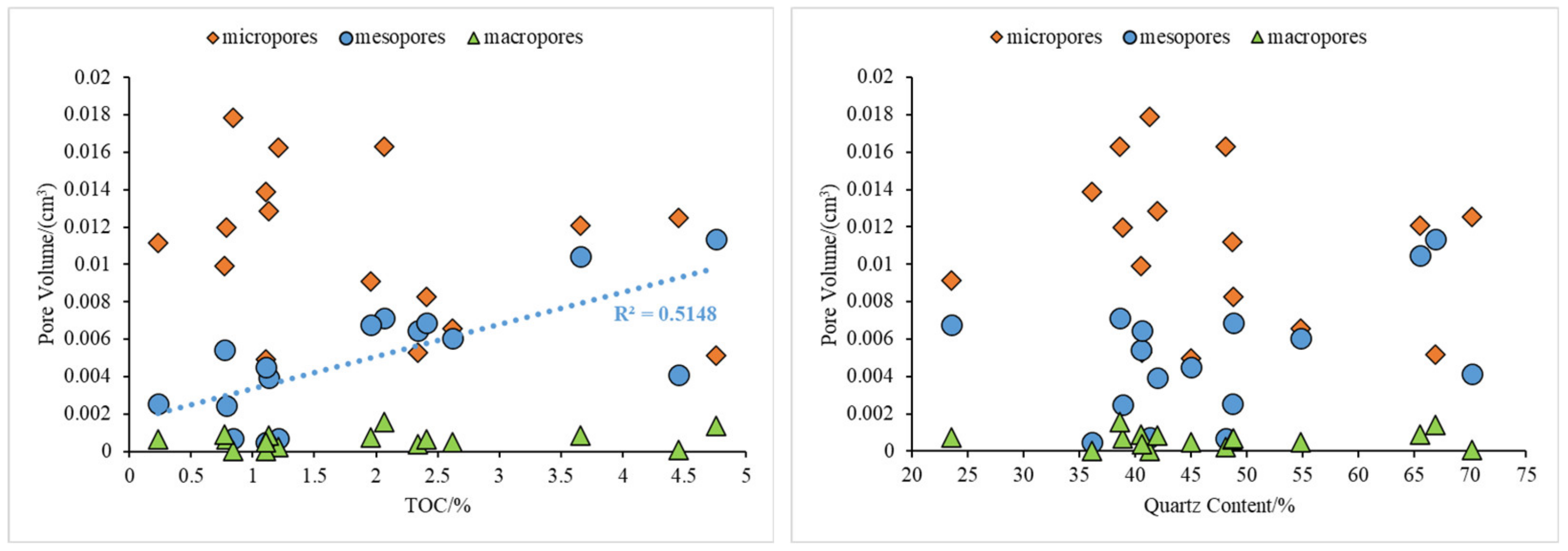
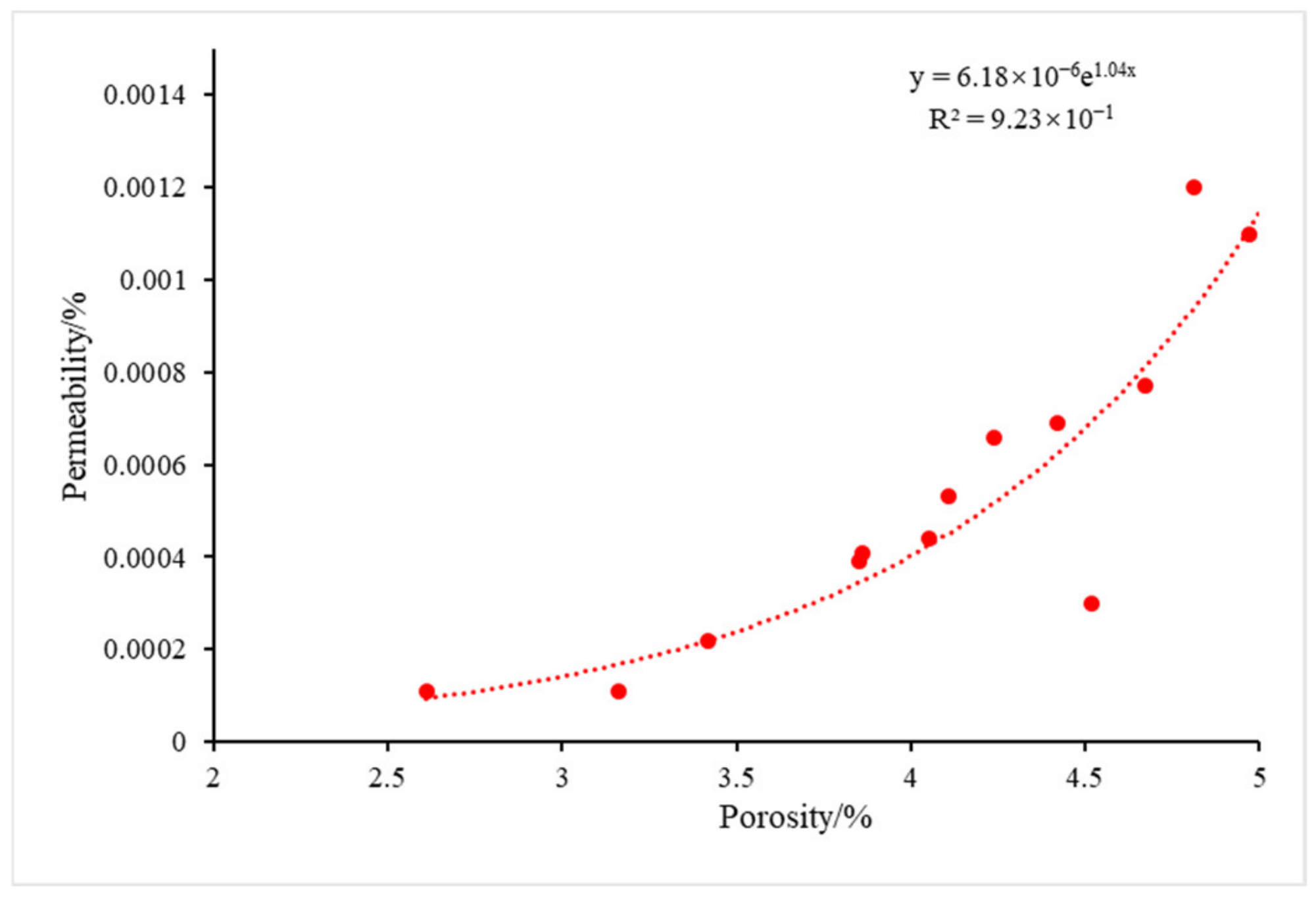

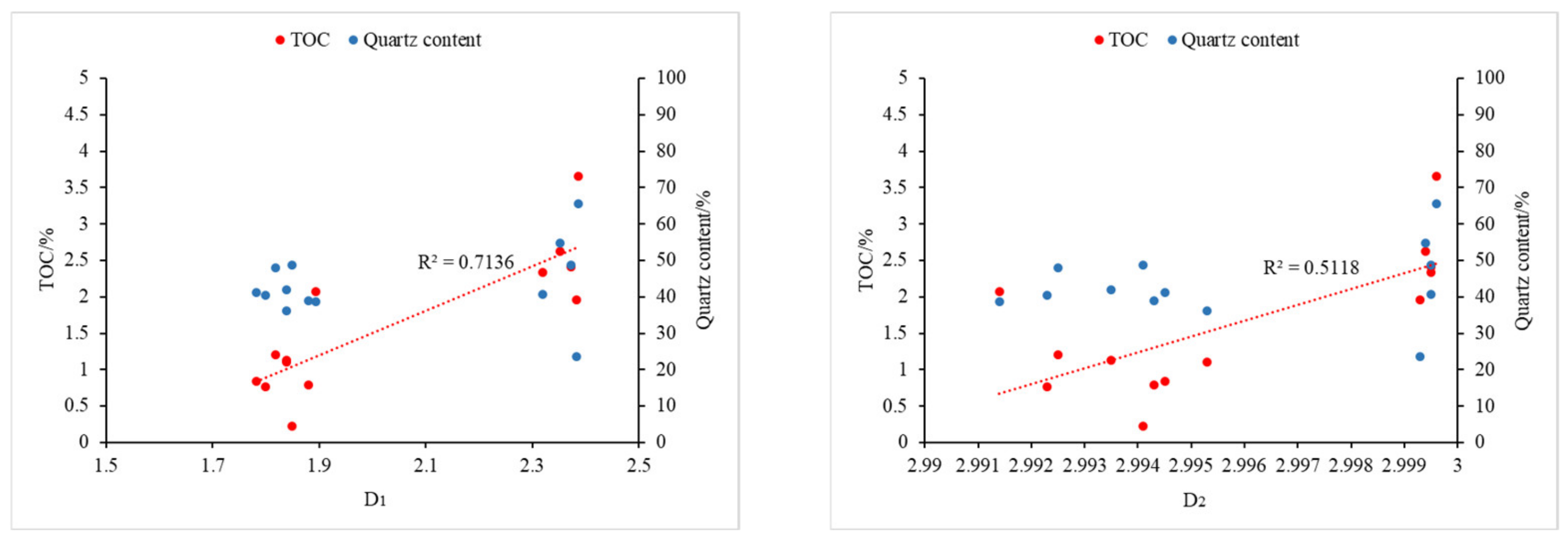
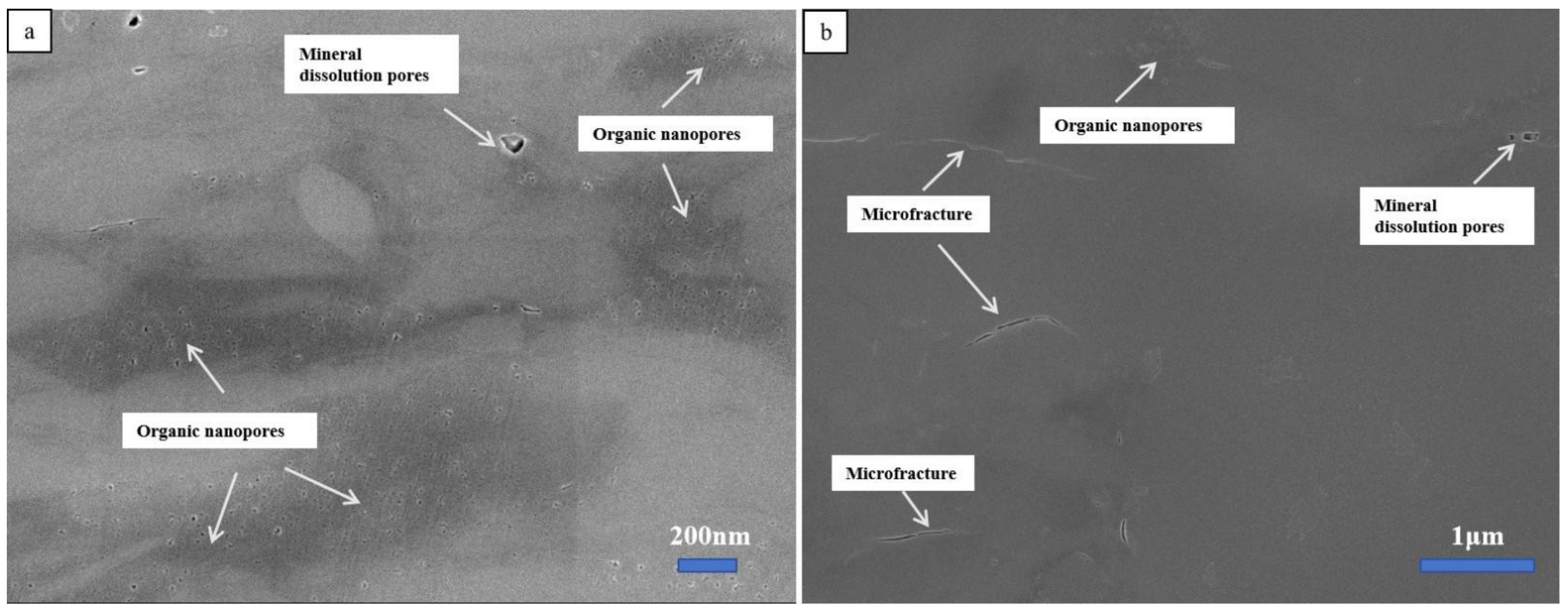
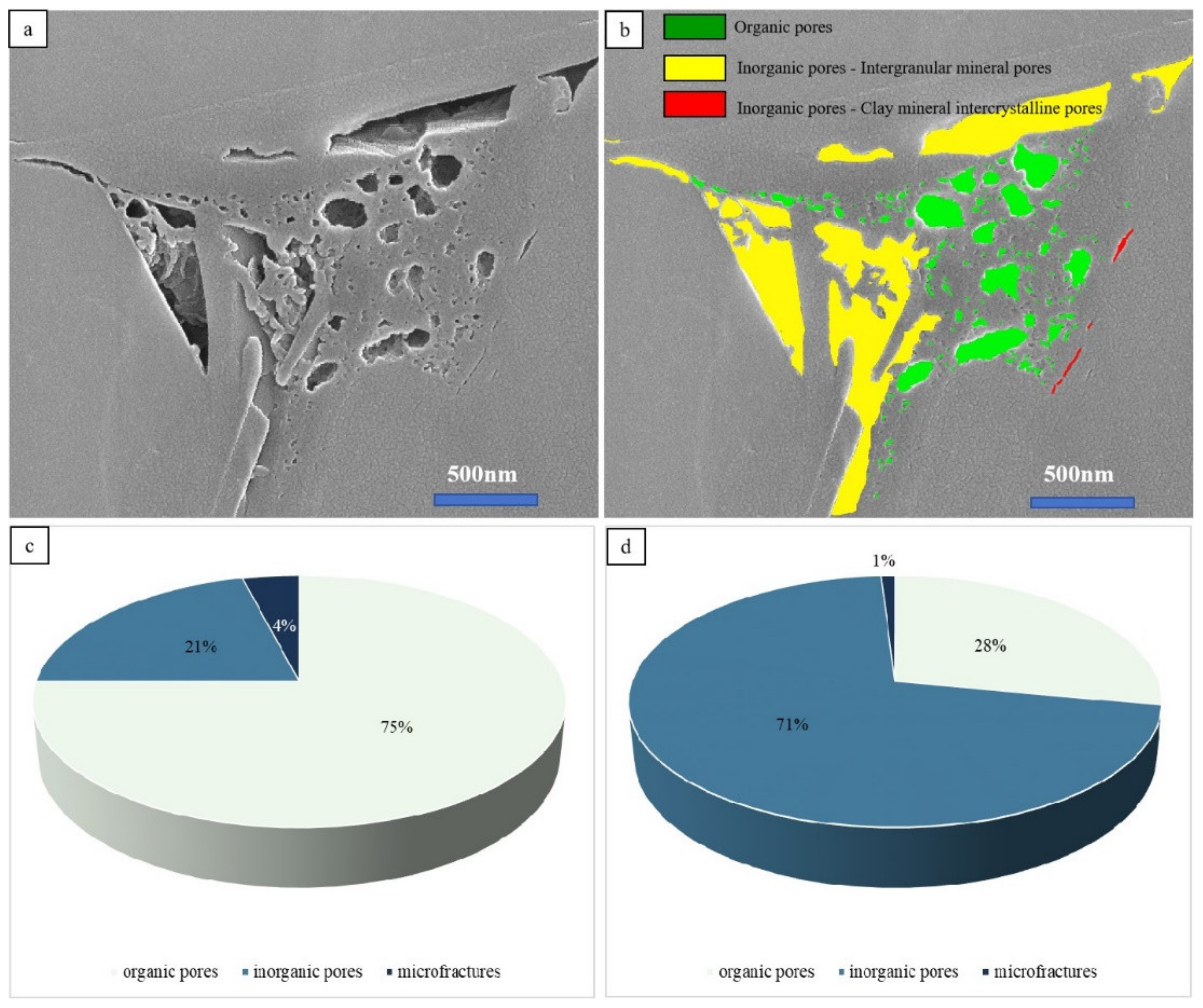

| Sample | Depth/m | Stratum | Lithology | Gas Content (m3/t) | TOC (%) | Quartz (%) | |
|---|---|---|---|---|---|---|---|
| Q0 | 4110.7 | Wufeng Fr. (Layer 1) | black carbonaceous shale | 0.96 | 1.11 | 45.0 | |
| Q1 | 4105.0 | Longmaxi Fr. | Bottom S1l1-1 sub-layer (Layer 2) | black carbonaceous shale | 2.33 | 4.45 | 70.1 |
| Q2 | 4101.2 | 2.65 | 4.76 | 66.9 | |||
| Q3 | 4096.1 | Lower S1l1-1 sub-layer (Layer 3) | black argillaceous shale | 1.80 | 2.62 | 54.8 | |
| Q4 | 4091.4 | 1.87 | 2.41 | 48.8 | |||
| Q5 | 4086.4 | 2.01 | 3.66 | 65.5 | |||
| Q6 | 4081.2 | Middle S1l1-1 sub-layer (Layer 4) | black silty shale | 1.87 | 1.96 | 23.5 | |
| Q7 | 4076.1 | 2.52 | 2.34 | 40.6 | |||
| Q8 | 4071.3 | 1.58 | 2.07 | 38.6 | |||
| Q9 | 4066.2 | 1.27 | 1.13 | 42.0 | |||
| Q10 | 4061.7 | Upper S1l1-1 sub-layer (Layer 5) | black silty shale | 1.34 | 0.77 | 40.5 | |
| Q11 | 4056.7 | muddy siltstone | 1.04 | 0.23 | 48.7 | ||
| Q12 | 4051.9 | black silty shale | 1.10 | 0.84 | 41.3 | ||
| Q13 | 4046.2 | S1l1-2 sub-layer (Layer 6) | silty mudstone, muddy siltstone | 0.92 | 1.11 | 36.1 | |
| Q14 | 4042.2 | 1.52 | 0.79 | 38.9 | |||
| Q15 | 4036.5 | 0.95 | 1.21 | 48.1 | |||
| Sample | Depth (m) | Layer | NMR Porosity (%) | Permeability (mD) | T2C (ms) |
|---|---|---|---|---|---|
| Q0 | 4110.7 | 1 | 2.61 | 0.00011 | 60.4400 |
| Q1 | 4105.0 | 2 | 4.17 | 0.235 | 35.7905 |
| Q2 | 4101.2 | 4.52 | 0.00030 | 16.3092 | |
| Q3 | 4096.1 | 3 | 3.42 | 0.00022 | 60.4400 |
| Q4 | 4091.4 | 4.11 | 0.00053 | 68.8991 | |
| Q5 | 4086.4 | 5.95 | 0.0041 | 68.8991 | |
| Q6 | 4081.7 | 4 | 4.42 | 0.00069 | 60.4400 |
| Q7 | 4076.1 | 3.16 | 0.00011 | 5.7190 | |
| Q8 | 4071.3 | 6.52 | 0.0046 | 2.9708 | |
| Q9 | 4066.2 | 4.67 | 0.00077 | 2.6061 | |
| Q10 | 4061.7 | 5 | 4.24 | 0.00066 | 2.9708 |
| Q11 | 4056.7 | 3.86 | 0.00041 | 2.2861 | |
| Q12 | 4051.9 | 4.97 | 0.0011 | 2.9708 | |
| Q13 | 4046.2 | 6 | 3.85 | 0.00039 | 2.6061 |
| Q14 | 4042.2 | 4.05 | 0.00044 | 2.6061 | |
| Q15 | 4036.5 | 4.81 | 0.0012 | 2.2861 |
| Sample | T2 < T2C | T2 > T2C | ||||
|---|---|---|---|---|---|---|
| Regression Equation | D1 | R2 | Regression Equation | D2 | R2 | |
| Q0 | y = 0.6298x − 0.5815 | 2.3705 | 0.6794 | y = 0.0006x − 0.002 | 2.9994 | 0.6136 |
| Q1 | y = 1.1415x − 1.0172 | 1.8585 | 0.7931 | y = 0.0009x − 0.0031 | 2.9991 | 0.6975 |
| Q2 | y = 1.3105x − 0.6905 | 1.6895 | 0.7567 | y = 0.0042x − 0.0137 | 2.9958 | 0.7247 |
| Q3 | y = 0.6486x − 0.5936 | 2.3514 | 0.676 | y = 0.0006x − 0.002 | 2.9994 | 0.6431 |
| Q4 | y = 0.6272x − 0.5943 | 2.3728 | 0.6618 | y = 0.0005x − 0.0015 | 2.9995 | 0.5868 |
| Q5 | y = 0.6143x − 0.5838 | 2.3857 | 0.6641 | y = 0.0004x − 0.0013 | 2.9996 | 0.6029 |
| Q6 | y = 0.6179x − 0.5822 | 2.3821 | 0.6548 | y = 0.0007x − 0.0025 | 2.9993 | 0.687 |
| Q7 | y = 0.6814x − 0.7024 | 2.3186 | 0.6735 | y = 0.0005x − 0.0019 | 2.9995 | 0.7308 |
| Q8 | y = 1.1068x − 0.1067 | 1.8932 | 0.8014 | y = 0.0086x − 0.0273 | 2.9914 | 0.7947 |
| Q9 | y = 1.1612x + 0.0004 | 1.8388 | 0.8053 | y = 0.0065x − 0.0203 | 2.9935 | 0.7439 |
| Q10 | y = 1.2005x − 0.0871 | 1.7995 | 0.8273 | y = 0.0077x − 0.0241 | 2.9923 | 0.7746 |
| Q11 | y = 1.151x + 0.0573 | 1.849 | 0.7993 | y = 0.0059x − 0.0182 | 2.9941 | 0.6959 |
| Q12 | y = 1.2187x + 0.1024 | 1.7813 | 0.8133 | y = 0.0055x − 0.0169 | 2.9945 | 0.7113 |
| Q13 | y = 1.1621x + 0.0584 | 1.8379 | 0.8037 | y = 0.0047x − 0.0144 | 2.9953 | 0.7132 |
| Q14 | y = 1.1208x + 0.0615 | 1.8792 | 0.79 | y = 0.0057x − 0.0173 | 2.9943 | 0.6792 |
| Q15 | y = 1.1815x + 0.0406 | 1.8185 | 0.8107 | y = 0.0075x − 0.0234 | 2.9925 | 0.8 |
| Sample | Pore Volume (10−3 cm3) | Total Pore Volume (10−3 cm3) | ||
|---|---|---|---|---|
| Micropores | Mesopores | Macropores | ||
| Q0 | 4.949 | 4.502 | 0.509 | 9.96 |
| Q1 | 12.520 | 4.123 | 0.070 | 16.713 |
| Q2 | 5.146 | 11.370 | 1.398 | 17.914 |
| Q3 | 6.572 | 6.064 | 0.483 | 13.119 |
| Q4 | 8.251 | 6.867 | 0.674 | 15.792 |
| Q5 | 12.084 | 10.454 | 0.875 | 23.413 |
| Q6 | 9.121 | 6.791 | 0.749 | 16.661 |
| Q7 | 5.287 | 6.476 | 0.404 | 12.167 |
| Q8 | 16.291 | 7.145 | 1.570 | 25.006 |
| Q9 | 12.865 | 3.945 | 0.857 | 17.667 |
| Q10 | 9.902 | 5.427 | 0.903 | 16.232 |
| Q11 | 11.176 | 2.569 | 0.651 | 14.396 |
| Q12 | 17.868 | 0.731 | 0.0399 | 18.6389 |
| Q13 | 13.882 | 0.481 | 0.042 | 14.405 |
| Q14 | 11.993 | 2.477 | 0.679 | 15.149 |
| Q15 | 16.271 | 0.694 | 0.225 | 17.19 |
Disclaimer/Publisher’s Note: The statements, opinions and data contained in all publications are solely those of the individual author(s) and contributor(s) and not of MDPI and/or the editor(s). MDPI and/or the editor(s) disclaim responsibility for any injury to people or property resulting from any ideas, methods, instructions or products referred to in the content. |
© 2024 by the authors. Licensee MDPI, Basel, Switzerland. This article is an open access article distributed under the terms and conditions of the Creative Commons Attribution (CC BY) license (https://creativecommons.org/licenses/by/4.0/).
Share and Cite
Zhao, D.; Liu, D.; Wei, Y.; Wang, Q.; Wang, S.; Zou, X.; Jiao, W.; Guo, Y.; Wang, G. Differentiated Interval Structural Characteristics of Wufeng−Longmaxi Formation Deep Shale Gas Reservoirs in Western Chongqing Area, China: Experimental Investigation Based on Low-Field Nuclear Magnetic Resonance (NMR) and Fractal Modeling. Appl. Sci. 2024, 14, 4733. https://doi.org/10.3390/app14114733
Zhao D, Liu D, Wei Y, Wang Q, Wang S, Zou X, Jiao W, Guo Y, Wang G. Differentiated Interval Structural Characteristics of Wufeng−Longmaxi Formation Deep Shale Gas Reservoirs in Western Chongqing Area, China: Experimental Investigation Based on Low-Field Nuclear Magnetic Resonance (NMR) and Fractal Modeling. Applied Sciences. 2024; 14(11):4733. https://doi.org/10.3390/app14114733
Chicago/Turabian StyleZhao, Difei, Dandan Liu, Yuan Wei, Qinxia Wang, Shengxiu Wang, Xiaoyu Zou, Weiwei Jiao, Yinghai Guo, and Geoff Wang. 2024. "Differentiated Interval Structural Characteristics of Wufeng−Longmaxi Formation Deep Shale Gas Reservoirs in Western Chongqing Area, China: Experimental Investigation Based on Low-Field Nuclear Magnetic Resonance (NMR) and Fractal Modeling" Applied Sciences 14, no. 11: 4733. https://doi.org/10.3390/app14114733






